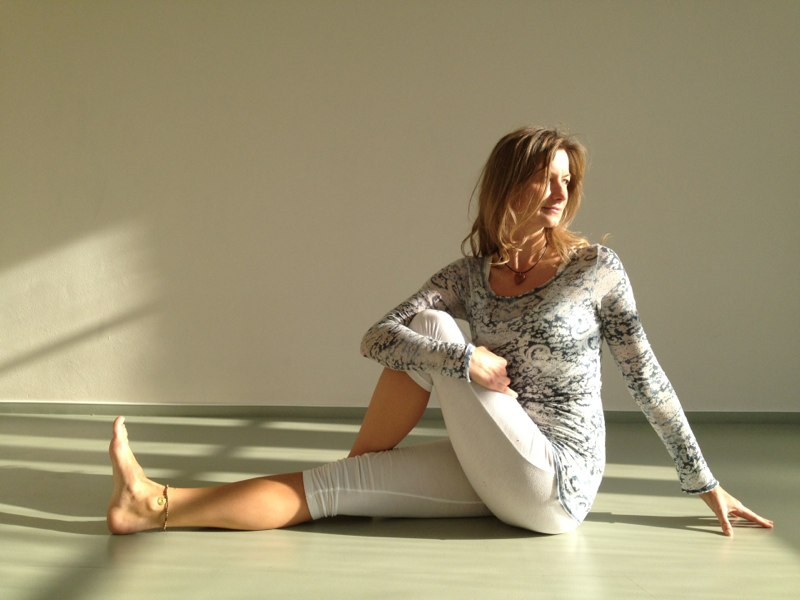Marichyasana C on:
[Wikipedia]
[Google]
[Amazon]
 Marichyasana ( sa, मरीच्यासन ; IAST: ''Maricyāsana'', the pose of the sage
Marichyasana ( sa, मरीच्यासन ; IAST: ''Maricyāsana'', the pose of the sage
 The name of the pose is from Sanskrit मरीचि
The name of the pose is from Sanskrit मरीचि
 This twisting asana is normally performed sitting. In Marichyasana I, one leg is stretched out straight ahead of the body, the other is bent with the sole of the foot on the floor and the knee up beside the body. The body is twisted towards the side with the straight leg, and the arms are clasped behind the back and around the raised knee. The body may then lean forwards until the nose and chin touch the straight leg.
This twisting asana is normally performed sitting. In Marichyasana I, one leg is stretched out straight ahead of the body, the other is bent with the sole of the foot on the floor and the knee up beside the body. The body is twisted towards the side with the straight leg, and the arms are clasped behind the back and around the raised knee. The body may then lean forwards until the nose and chin touch the straight leg.
 Marichyasana ( sa, मरीच्यासन ; IAST: ''Maricyāsana'', the pose of the sage
Marichyasana ( sa, मरीच्यासन ; IAST: ''Maricyāsana'', the pose of the sage Marichi
Marichi ( sa, मरीचि, Marīci, lit=ray of light) or Mareechi or Marishi is the mind-born son of Brahma, and one of the Saptarishi in Hindu mythology. He is also the father of Kashyapa, and the grandfather of the ''devas'' and the ...
) is a sitting twist asana in modern yoga as exercise
Yoga as exercise is a physical activity consisting mainly of postures, often connected by flowing sequences, sometimes accompanied by breathing exercises, and frequently ending with relaxation lying down or meditation. Yoga in this form has ...
, in some forms combined with a forward bend.
Etymology and origins
 The name of the pose is from Sanskrit मरीचि
The name of the pose is from Sanskrit मरीचि Marichi
Marichi ( sa, मरीचि, Marīci, lit=ray of light) or Mareechi or Marishi is the mind-born son of Brahma, and one of the Saptarishi in Hindu mythology. He is also the father of Kashyapa, and the grandfather of the ''devas'' and the ...
, the name of a sage in Hindu mythology, and आसन, ''āsana'', meaning posture or seat.
The pose is not found in medieval hatha yoga texts, but is described in Krishnamacharya's 1934 ''Yoga Makaranda
''Yoga Makaranda'' (Sanskrit: योग मकरन्द), meaning "''Essence of Yoga''", is a 1934 book on hatha yoga by the influential pioneer of yoga as exercise, Tirumalai Krishnamacharya. Most of the text is a description of 42 asana ...
'' and in the teaching of his pupils, B. K. S. Iyengar and Pattabhi Jois.
Description
 This twisting asana is normally performed sitting. In Marichyasana I, one leg is stretched out straight ahead of the body, the other is bent with the sole of the foot on the floor and the knee up beside the body. The body is twisted towards the side with the straight leg, and the arms are clasped behind the back and around the raised knee. The body may then lean forwards until the nose and chin touch the straight leg.
This twisting asana is normally performed sitting. In Marichyasana I, one leg is stretched out straight ahead of the body, the other is bent with the sole of the foot on the floor and the knee up beside the body. The body is twisted towards the side with the straight leg, and the arms are clasped behind the back and around the raised knee. The body may then lean forwards until the nose and chin touch the straight leg.
Variations
In Marichyasana II, the leg on the ground is folded as for padmasana (lotus), while the other leg is bent as in Marichyasana I; the body is twisted towards the leg on the ground, and the arms are clasped behind the back and around the raised knee. The body may then be leant forwards until the chin touches the knee that is resting on the ground. In Marichyasana III, the leg on the ground is stretched out straight. The body is twisted towards the side with the bent leg, and again the arms are clasped behind the back and around the raised knee. Marichyasana IV puts together the movements of Marichyasana II and III. The leg on the ground is folded as for padmasana; the body is twisted towards the raised knee. This asana may also be performed standing, the foot of the bent leg resting on the seat of a chair and the body turned across the bent leg to face a wall.Benefits
Standing Marichyasana is stated to be helpful in relieving backache.See also
*Bharadvajasana
Bharadvajasana ( sa, भरद्वाजासन; IAST: ''Bharadvājāsana'') or Bharadvaja's twist is a twisting asana in modern yoga as exercise.
Etymology and origins
The asana is dedicated to the sage Bharadvāja who was one of the Se ...
, a seated twist with both knees on the floor
* Jathara Parivartanasana, a reclining twist with both knees to one side
* Matsyendrasana
Matsyendrasana ( sa, मत्स्येन्द्रासन; IAST: ''Matsyendrāsana''), Matsyendra's Pose or Lord of the Fishes Pose, is a seated twisting asana in hatha yoga and modern yoga as exercise. The full form is the difficult Pari ...
, a seated twist with one knee up
References
Sources
* * {{Yoga as exercise Sitting asanas Twisting asanas Hip-opening asanas Asymmetric asanas